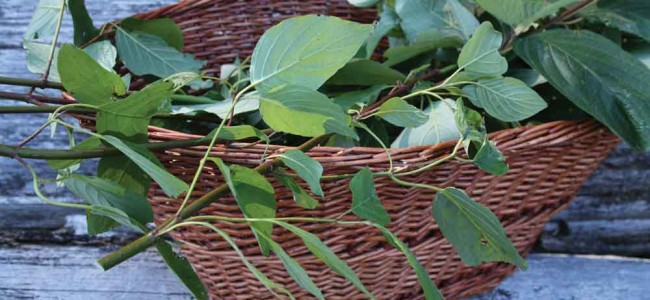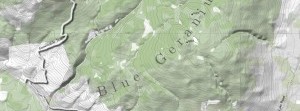
Photo Credit: Norma Kerby
Sticks, stumps, and twigs: The DIY lumberyard of the North
“How about this one?” The tide was low and we were looking for solid sticks to brace ourselves as we waded across the Tlell River. It wasn’t that the water was very high at the ford where trucks cross the river to travel up the east coast of Haida Gwaii. The rocks had a slick coating of algae and slipping could lead to cut knees and wet packs.
A couple of faces were staring out the window of the tourism lodge as we carefully picked our way through the shallow, brown water. Sitting on a log to do up my boots, the thought occurred to me that, if we had been crossing Granville Street in Vancouver on one of the south coast’s rare snowfalls, there wouldn’t be any dead spruce branches to break off and use to avoid falling. In fact, in the city, sticks and logs and even rocks are not to be had in a sea of pavement.
In northern BC, wood is good for more than just making lumber or burning for heat. Surrounded by trees, many of us view the forests and water edges as supermarkets of useful materials. Need a trellis to grow your garden peas? Long supple young alders or willows from under the power line make sturdy tripods. Is your fence suffering from droop after a large moose did not quite make its majestic leap over the top? Durable cedar poles to brace up the wires will do until the fence can be mended. Did you lose your walking cane? The closest bank beaver’s lodge will have pre-cut, pre-barked birch sticks to rival any speed walker’s poles.
Each tree and shrub species in northern BC has wood with specific qualities that First Nations recognized and utilized. European fur traders and early settlers followed the wisdom of the First Nations and adopted wood best suited for the various needs of living in a northerly climate. Oral traditions amongst northern BC residents have maintained this knowledge. From fish clubs made of western yew to a wood stove handle carved from a birch branch, northerners appreciate the values of each type of wood.
If you were building a log cabin a hundred years ago, which type of tree you used depended upon where you lived and the climate’s wetness. Decades after he died, a certain Englishman in the Terrace area was still infamous for having built his cabin out of pine. I can remember my father quietly pointing out the ruins of that cabin next to the old Lakelse Lake road. Speaking in hushed tones, he explained how, in our damp climate with an Olympic rate of decay, you used rot-resistant cedar for everything—cabins, fence posts, woodsheds and steps. Never pine.
Pine was also considered a pariah for smoking fish due to its pitchy taste. According to the locals, red alder, maple and paper birch are the best. They give good, clean smoke and a slow burn. Hemlock, spruce and cedar burn too quickly and leave an aftertaste. Nobody ever uses cottonwood to smoke fish, although many of the old timers packed a small tin of dry, punky cottonwood as fire starter.
Smoke houses are also constructed of wood in the North. Most smoke shacks consist of loosely constructed sheds made from cedar or spruce planks. Building for utility, they lean and sag in a hundred directions, smoke puffing out from the cracks between the boards. My grandfather had a huge hollow hemlock stump from the early cross-cut-saw days for his smoke house. Looking like an elf’s giant mushroom cabana, each fall it was filled with alder smoke and split, salted fish hung on narrow maple branches.
Stumps are useful for more than smoke houses. We northerners appear to have a love affair with stumps—stumps as tables, stumps covered by flower planters, summer cabin stumps with wash basins perched on them, even stump ranches, where stumps substitute for fence posts, gates and sometimes fields. And then there are the trophy stumps. From riverbanks, lakes and seashores, we drag stumps and butt ends of logs home to decorate our gardens, driveways and sundecks. More unique and entertaining than garden gnomes and pink plastic flamingos, these stumps age into moss- and lichen-covered toad habitat that blends back into the bushes.
In each region, the wood from our trees is valued for different reasons. On the wet north coast, cedar is the queen of wood due to its straight grain and ability to win the ongoing chemical war with wood-rotting fungi. In the drier and colder parts of the northern interior, lodgepole pine, as its name suggests, was widely used during fur trading and pioneer times to build cabins due to its long, straight poles. Another important species in the drier northern climate is paper birch, with its strong, flexible wood used to make many household items, including furniture, tool handles and snowshoe frames.
Some of the most interesting wood in northern BC, though, is from the less obvious species. Red osier dogwood is a shrub found in damper sites. Sometimes called red willow, its long, straight spring stems are woven to make baskets, chairs and other furniture and containers. In contrast, the very flexible branches of slide alder can literally be tied into knots. This is incorporated into items that require strength and flexibility, such as sled braces. Hazelnut is an even more unusual species. Found in the Hazelton area, and occasionally in old village sites along the lower Skeena River, it is a vigorous shrub whose bendable branches were twisted by the Gitxsan to make a durable cord. All three shrub species are still used by farmers, ranchers and other wood lovers as bush “rope” in emergencies and as flexible catch-all stems by rural gardeners.
One of the prettiest woods in the North is red alder. Exposed to the air, it turns to a deep orange-red. A tough and even-grained hardwood, it once was used in BC’s commercial furniture industry. Largely ignored now, it is prized by First Nations as an excellent species for carving masks and bowls. I use long, straight logs of red alder that have died from being shaded out in the forest. They make excellent poles to hold down tarps and garden cloth from storm winds.
Northern BC is a smorgasbord of wood for all types of needs and emergencies. If you were sitting on a bench on Granville Street and reached underneath, you might not want to grab on to what is there. If you sit on the log at the end of Beitush Road, with the tide low and the Tlell River running in shallow ripples over the rocks, reach under the log and there still might be three knobby spruce sticks there, just the right lengths for a safe journey to the other side.
Woods for all seasons
Our major tree species are a cornucopia of useful wood. Amongst them are western redcedar (Thuja plicata), western yew (Taxus brevifolia), Sitka spruce (Picea sitchensis) and black cottonwood (Populus subsp. trichocarpa) on the coast. In the Interior, white spruce (Picea glauca), Engelmann spruce (Picea engelmannii), trembling aspen (Populus tremuloides) and lodgepole pine (Pinus contorta var. latifolia) include some of the best sources of utility wood for household uses. Red alder (Alnus rubra) and paper birch (Betula papyrifera) are two deciduous trees with excellent wood for making handles, bowls and furniture. Shrubs that have wood with unique qualities in terms of fibre strength and durability include Douglas maple (Acer glabrum), red osier dogwood (Cornus stolonifera), Sitka (slide) alder (Alnus crispa subssp. sinuata) and beaked hazelnut (Cornus cornuta var. californica).





